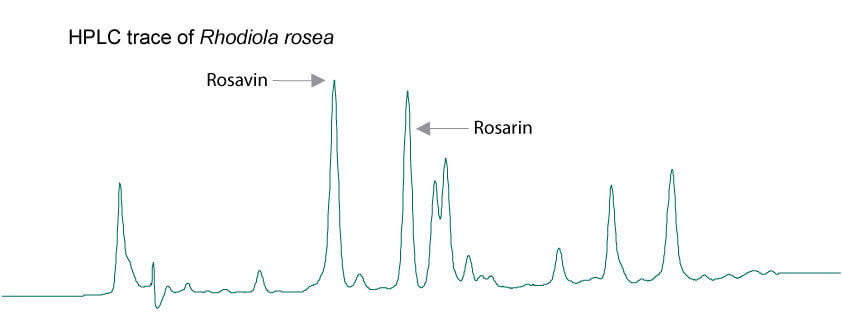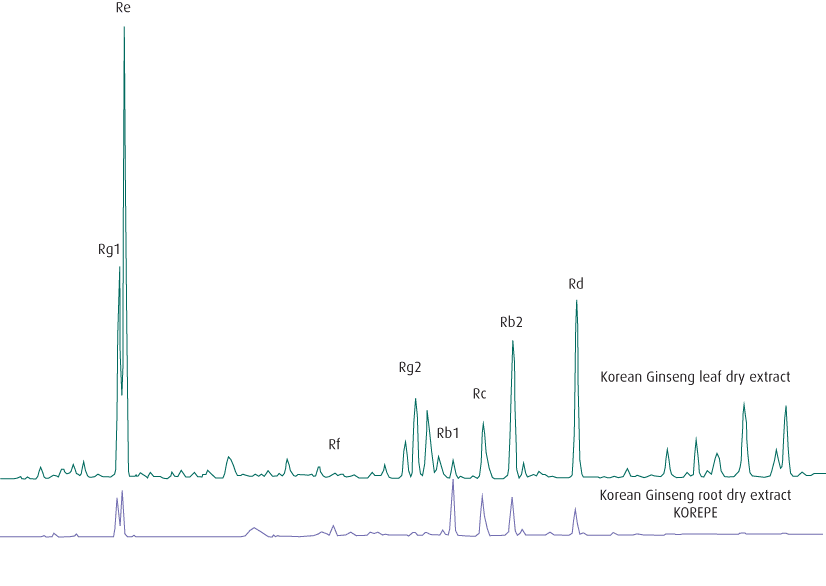Rhodiola & Ginseng Complex is an adaptogenic tonic which contains Rhodiola root and Korean Ginseng to enhance vitality and stamina.*
These herbs have been traditionally used in herbal preparations to:
- Support mental clarity and cognitive function*
- Promote vitality and stamina*
- Help maintain proper energy*
- Support physical endurance*
The combination of herbs in Rhodiola & Ginseng Complex contains many compounds including phenylpropanoids such as rosarin, rosavin and rosin (rosavins), salidroside (a hydroxyphenethyl glucoside), and a complex mixture of steroidal saponins (called ginsenosides). This product is standardized to contain 4.5 mg of rosavins, 1.5 mg of salidroside and 8.4 mg of ginsenosides (calculated as Rb2 to Rb1 is NLT 0.4 by HPLC) per tablet to ensure optimal strength and quality.
Rhodiola and Korean Ginseng Quality Stories

Rhodiola Quality Story
Rhodiola rosea (Sedum roseum) is commonly referred to as Golden Root or Roseroot and grows in dry sandy ground at high altitudes in the arctic regions of Europe and Asia. The freshly cut root has a rose-like odor that has led to its botanical name and one of its common names. The root has been used for centuries in the traditional medicines of Russia and Scandinavia. There are however 16 common species of Rhodiola growing in the Eurasian area. Of these, 11 have been tested in animal studies, but only R. rosea and to a far lesser extent R. crenulata have been assessed in human trials.
Most of the Rhodiola species have been reported to contain the marker compound salidroside and this was originally used to standardize extracts of Rhodiola rosea. After more than a decade of research, however, it was shown that the chemical composition of R. rosea root is, in fact, different to the other species of the genus Rhodiola. Using newly developed methods of analysis, it was shown that R. rosea root contains three cinnamyl alcohol-vicianosides: rosavin, rosin, and rosarin that are specific to this species. They are collectively termed rosavins. HPLC offers a ready method to differentiate true Rhodiola rosea from the other species offered on the market. The two major rosavins found are rosavin and rosarin, with only very low quantities of rosin.

Korean Ginseng Quality Story
Panax ginseng is a widely used and misunderstood herb. Traditionally the main root of the plant has been preferred for clinical use. The other parts of the plant such as the root hairs, leaves, leafstalks, etc., are considered inferior and are never used clinically in the East. However, many herb traders will sell the other plant parts as they are substantially cheaper than the main root. The major marker compounds used to characterize Panax ginseng are the ginsenosides which occur in all parts of the plant and if you were to only consider total ginsenosides the main root is not the highest in content. The importance is in the ratio of specific ginsenosides. The European clinical studies were undertaken on extracts manufactured from the main root of Panax ginseng which have a particular ratio of ginsenosides. To achieve the clinical results obtained traditionally and supported by clinical trials it is important to use raw material from the correct plant part and the correct species. This is readily acheivable using HPLC which easily distinguishes the different preparations.
| % Content |
| |
Rg1 |
Re |
Rf |
Rg2 |
Rb1 |
Rc |
Rb2 |
Rd |
Total |
| Leaves |
1.078 |
1.524 |
— |
— |
0.184 |
0.736 |
0.553 |
1.113 |
5.188 |
| Leafstalks |
0.327 |
0.141 |
— |
— |
— |
0.190 |
— |
0.107 |
0.765 |
| Stem |
0.292 |
0.070 |
— |
— |
— |
— |
0.397 |
— |
0.759 |
| Main root |
0.379 |
0.153 |
0.092 |
0.023 |
0.342 |
0.190 |
0.131 |
0.038 |
1.348 |
| Lateral roots |
0.406 |
0.668 |
0.203 |
0.090 |
0.850 |
0.738 |
0.434 |
0.143 |
3.532 |
| Root hairs |
0.376 |
1.512 |
0.150 |
0.249 |
1.351 |
1.349 |
0.780 |
0.381 |
6.148 |
| Main root dry extract |
1.4 |
2.1 |
0.6 |
0.6 |
2.9 |
1.9 |
2.4 |
1.5 |
13.4 |